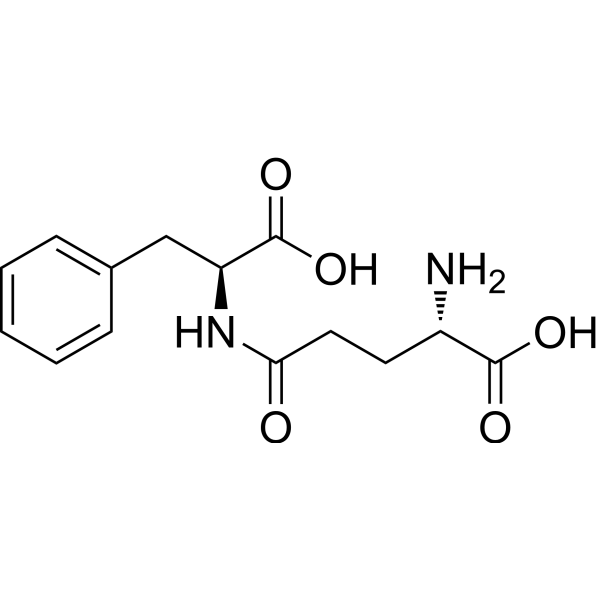| Cas No.: | 7432-24-8 |
| Chemical Name: | Glutamylphenylalanine |
| Synonyms: | L-Phenylalanine, L-g-glutamyl-;γ-Glutamylphenylalanine;2-amino-5-[(1-carboxy-2-phenylethyl)amino]-5-oxopentanoic acid;GAMMA-GLU-PHE;H-Glu(Phe-OH)-OH;H-γ-Glu-Phe-OH;L-g-Glutamyl-L-phenylalanine |
| SMILES: | OC(C(CCC(NC(CC1C=CC=CC=1)C(=O)O)=O)N)=O |
| Formula: | C14H18N2O5 |
| M.Wt: | 294.30312 |
| Purity: | >98% |
| Sotrage: | 2 years -20°C Powder, 2 weeks 4°C in DMSO, 6 months -80°C in DMSO |
| Description: | γ-Glu-Phe (γ-Glutamylphenylalanine) is synthesized by Bacillus amyloliquefaciens (GBA) and Aspergillus oryzae (GAO). γ-Glu-Phe or the post-enzymatic reaction mixture enhances the umami intensity of commercial soy sauce and model chicken broth. |
| In Vitro: | γ-Glu-Phe, γ-Glu-Met and γ-Glu-Val, are identified in sourdough by liquid chromatography-tandem mass spectrometry in MRM mode. γ-Glutamyl dipeptides are found in higher concentrations in sourdough fermented with L. reuteri when compared to the chemically acidified controls. Proteolysis is an important factor for generation of γ-glutamyl dipeptides. Sensory evaluation of bread reveals that sourdough bread with higher concentrations of γ-glutamyl dipeptides ranks higher with respect to the taste intensity when compared to regular bread and type I sourdough bread. Sourdough breads fermented with L. reuteri LTH5448 and L. reuteri 100-23 differ with respect to the intensity of the salty taste; this difference corresponds to a different concentration of γ-glutamyl dipeptides[1]. |
| References: | [1]. Zhao CJ, et al. Synthesis of Taste-Active γ-Glutamyl Dipeptides during Sourdough Fermentation by Lactobacillus reuteri. J Agric Food Chem. 2016 Oct 12;64(40):7561-7568. |

 To enhance service speed and avoid tariff delays, we've opened a US warehouse. All US orders ship directly from our US facility.
To enhance service speed and avoid tariff delays, we've opened a US warehouse. All US orders ship directly from our US facility.




















